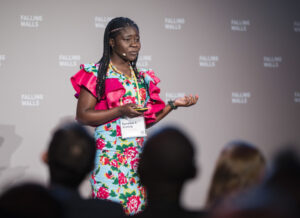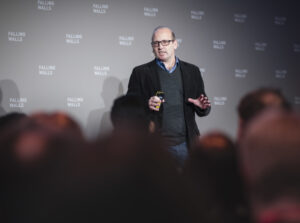By Uzman Unis Bah
Science Engagement is crucial for solving global challenges, producing seamless solutions to the enduring problems affecting our planet, from pandemics to technology; experts at the berlin science conference discuss action-oriented projects that reflect on Science Engagement challenges and solutions.
Falling Walls Engage, hosted by the Falling Walls Foundation in cooperation with Robert Bosch Stiftung, is a global platform for Science Engagement that aims to inspire and connect creative individuals and organizations who actively involve the public with science to generate mutual benefits for society, all around the world.
The Quality Manager at Falling Walls Engage & International Year of Science Engagement (IYSE), Ana Faustino, said science would only be made accessible to everyone through Science Engagement.
“Science Engagement consists, in involving individuals outside of the scientific community in science initiatives, to contribute to improved science literacy, wellbeing and informed decision-making in society,” said Ana.
Falling Walls Foundation coordinates the Falling Walls Engage and the Berlin Science Week, a 10-day international festival, customarily from November 1st to 10th. The occasion brings together the most innovative scientific organizations to celebrate science and creates a space for an open and interdisciplinary exchange of ideas and information.
In the year 2021, projects developed by the Falling Walls Engage community members Ana Faustino, Bernard Appiah, Julian Ferreras, Kyerewaa Boateng and Stephanie Okeyo – tackled the challenges of the institutionalization of Science Engagement.
Ana said Science journalism is one of the ways to make sure the public, industry leaders and policymakers understand, appreciate and trust the deftness. Promoting science literacy and dialogue in helping tackle the global societal challenges of our time. “Regarding the future of science journalism, in my opinion, science journalism should focus more and more on speaking about world problems and presenting scientific solutions to tackle them,” mentioned Ana.
In addressing pandemics, conducting sensitizations, diagnostic tests, developing vaccines, science actions are decisive. The one health approach, which brings agriculture, human, and animal health experts together to research diseases, a prerequisite for public health responses, vastly owing to science engagements.
Science engagement is two-way communication, and feedback to the communities is indispensable. Scientists do not know it all. “To understand how communities’ function and perceive science, we need to plan, co-design, and share decisions,” posited Ana.

Kyerewaa Boateng, A research scientist at the West African Centre for Cell Biology of Infectious Pathogens (WACCBIP), University of Ghana, uses a science engagement toolkit, a docu-drama engaging the hearing impaired, their families, and neighbourhoods in Ghana.
The performances aim at engaging the deaf students and their families; it also engages researchers to strengthen genetics research to address the issue of the hearing impaired. As a science engagement specialist, the falling walls engage community has connected her to other science engagers who are equally finding solutions to challenges in their communities.

Julian Ferreras, a scientist at the Institute of Subtropical Biology (UNaM-CONICET) and a professor at the Misiones National University, in Northeastern Argentina, currently focusing his research on drug discovery from natural products. According to Julian, there are many approaches, strategies, and formats for science engagements, noting that empathy is the primary requirement to establish any successful connection.
Ferreras states that science engagement is crucial in supporting the development of Africa and the southern continent. He mentioned, science engagement will support the development of the continent, but it is a requirement.

Microbiologist and Science Communicator – Stephanie Okeyo’s Climate Change series project aims to Break the wall of climate change scepticism, making the issue of climate change more relatable to the day to day activities and giving evidence-based data and educating and promoting action on climate change.
Inspiring Scientific Artistry Collaborations.
Science engagement is all about bridging the gap between science and society, and the media is a powerful tool for facilitating this aspect.
“Science and innovation are essential components of development for a young continent such as Africa; this process not only involves supporting research and development that tackle the most pressing community challenges but also creates an environment that enables young people to be entrepreneurs and encourages the uptake of sustainable homegrown solutions,” Okeyo said.
Dr Bernard Appiah, the Director, Research Program in Health Communication and Public Engagement (H-COPE), Department of Public Health, Syracuse University, USA, notes, “Science engagement could make the public aware of innovative arts-based approaches to change their behaviour positively to prevent and address novel epidemics.”
Dr Appiah, who also serves as the Director – of the Centre for Science and Health Communication in Ghana, exploits his winning project in addressing Antimicrobial resistance.
Appiah employs the potential of using storytelling and picture-drawing to improve knowledge, beliefs and attitudes of school children aged 11-15 in Ghana, raising awareness of Antimicrobial resistance.
Antimicrobial resistance occurs due to the misuse of medicines, including antibiotics. Prevalent these days, Bacteria, viruses, fungi and parasites change over time and no longer respond to drugs making infections harder to treat and increasing the risk of disease spread, severe illness and death.
Dr Appiah cited the COVID-19 outbreak; regarded science engagement as critical in helping the public know how to take preventive measures such as washing hands with soap and water, getting vaccinated, and how to prevent spreading the disease.
Appiah states that Science engagement can lead to innovative approaches such as storytelling, picture drawing, dialogues and songs for tackling animal to human disease transmissions.








